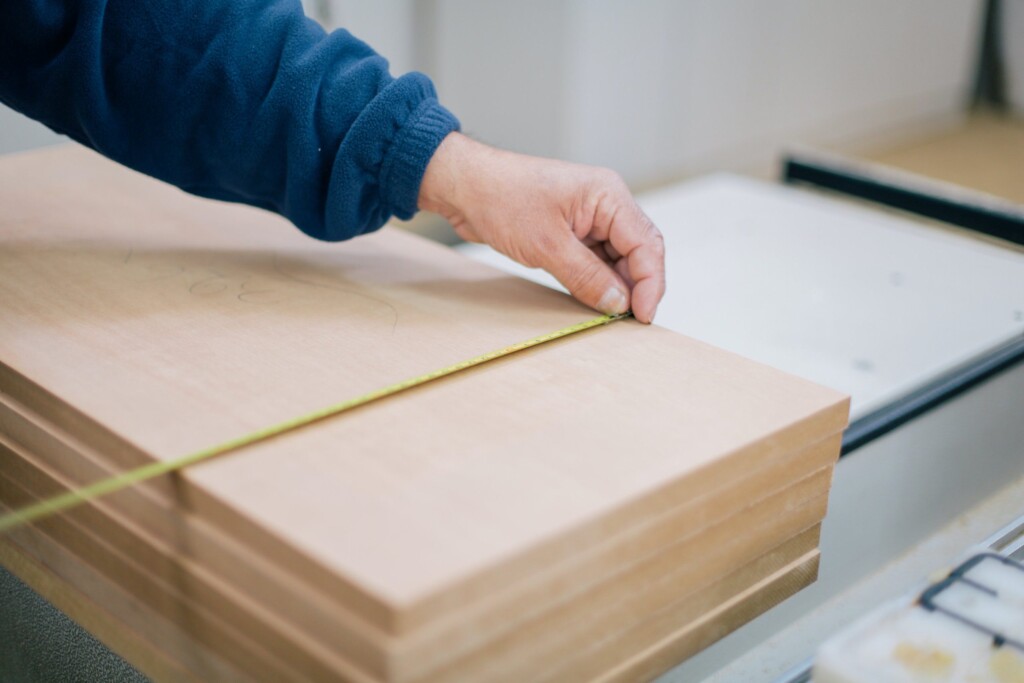
Overlay Cabinet Door Measurement Guide
Master the art of measuring cabinet doors with overlay to ensure a perfect fit every time!
Understanding Overlay
An overlay is the amount a cabinet door overlaps the cabinet frame or opening. It's crucial for achieving your desired look and fit.
The most common standard overlay is ½ inch.
How to Measure: Single Doors
Follow these simple steps to get precise measurements for a single cabinet door.
Step 1: Measure the Opening
- ✅ Measure the width of the opening.
- ✅ Measure the height of the opening.
- ⚠️ Measure at several points (top, middle, bottom for width; left, middle, right for height) to ensure the opening is square.
Step 2: Add the Overlay
For an overlay, you need to add to both the width and height of the opening. A standard ½ inch overlay means adding a total of 1 inch (½ inch per side/edge).
Total Door Width = Opening Width + ½" (left) + ½" (right)
Total Door Height = Opening Height + ½" (top) + ½" (bottom)
Single Door Calculator
Calculated Door Width: -- inches
Calculated Door Height: -- inches
How to Measure: Double Doors
If your cabinet opening is wide enough for two doors, here's how to measure for a perfect pair. Remember to account for a small clearance gap between the two doors.
Step 1: Calculate Total Door Width (with overlay)
Measure the opening width and add the total overlay (½ inch for the left door's left edge, and ½ inch for the right door's right edge).
Total Combined Door Width = Opening Width + ½" (left) + ½" (right)
Step 2: Account for Clearance Gap
To prevent a collision between the doors, subtract a ⅛ inch (0.125") clearance gap from the total combined width. This ⅛" gap is split between the two doors, meaning each door will be 1/16" narrower to create this space. Hinge adjustments may be used after installation to decrease this gap if needed.
Step 3: Divide for Each Door
Divide the adjusted total width by two to get the width for each individual door.
Each Door Width = (Total Combined Door Width minus ⅛" Clearance) / 2
The height measurement for each door remains the same as for a single door: Opening Height + ½" (top) + ½" (bottom).
Double Door Calculator
(accounts for 1/8" gap)
Calculated Width for EACH Door: -- inches
Calculated Height for EACH Door: -- inches
Drawer Box Measurement Guide
How to Measure: Drawer Box Dimensions
Accurately determine the width, height, and depth of your drawer box based on your cabinet opening.
Step 1: Measure Cabinet Opening
- ✓ Measure the width and height of the cabinet opening.
- ✓ Measure the depth of the opening by measuring from the front face of the face frame to the back wall of the cabinet.
- ⚠️ For drawers with inset drawer fronts, you must subtract the drawer front's thickness from the final calculated depth.
Step 2: Calculate Drawer Box Size for
Our 5/8″ maple drawer box width should be: Cabinet opening width minus 3/8″
Our 5/8″ maple drawer box height should be: Cabinet opening height minus 13/16″
Our 5/8″ maple drawer box depth is dependent on the slide length when used with undermount slides.
Drawer Box Size Calculator
Drawer depth measuring info for undermount slides

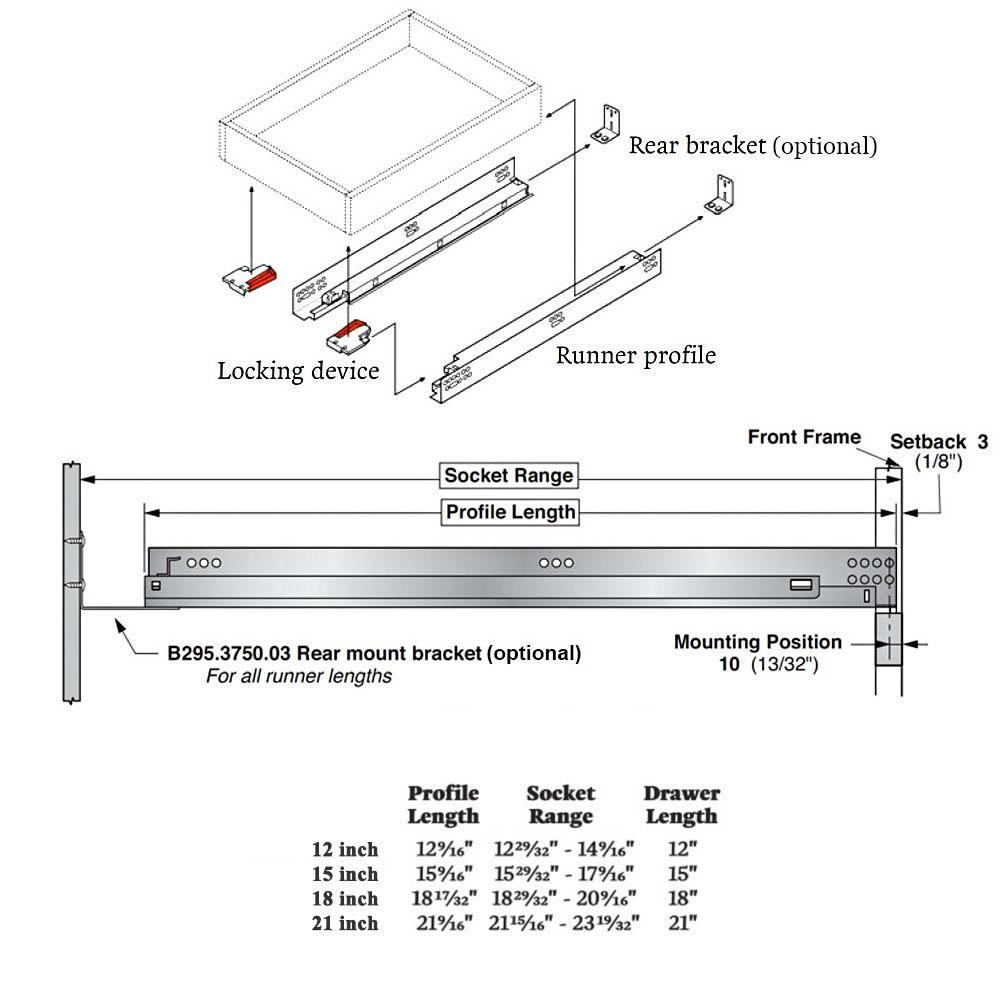
Choosing the Right Wood for Cabinets

When choosing wood for cabinet doors, there are a few factors to consider, such as the color, the grain, the durability, and the cost. The best wood for you will depend on your individual needs and preferences.
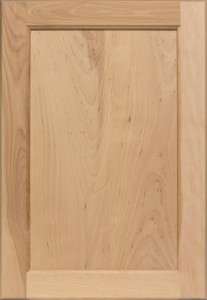
Birch
Birch is a hardwood that has a pleasing light color in our Select grade. It's a good choice for painted cabinets, as it takes paint well. We offer three grades of birch.
 Rustic: Knotty wood with natural color variation.
Rustic: Knotty wood with natural color variation.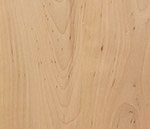 Natural: Some mineral streaks and color variation.
Natural: Some mineral streaks and color variation. Select: No knots, uniform color, well-matched wood. Recommended if using light stain.
Select: No knots, uniform color, well-matched wood. Recommended if using light stain.
Red Oak
Red oak is another hardwood that is popular for cabinet doors. It has a distinct grain pattern and is a good choice for high-traffic areas. The slight reddish tint can add warmth and character to a kitchen. Because of its pitted cellular structure, red oak can be painted while allowing the grain texture to show through.
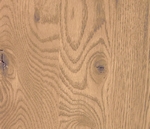 Rustic: Knotty wood with natural color variation.
Rustic: Knotty wood with natural color variation.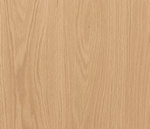 Natural: Some mineral streaks and color variation.
Natural: Some mineral streaks and color variation. Select: No knots, uniform color, well-matched wood.
Select: No knots, uniform color, well-matched wood.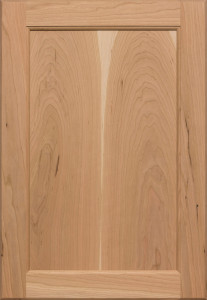
Cherry
Cherry is a hardwood known for its rich warm color and fine grain, making it a good choice for traditional or transitional style kitchens. We offer a Budget Cherry that has extra color variation, no knots, and is not recommended for light colored stain. We also offer three grades of standard cherry.
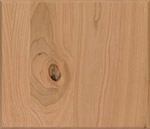 Rustic: Knotty wood, color variation, some sapwood.
Rustic: Knotty wood, color variation, some sapwood. Natural: Some mineral streaks, color variation, and sapwood.
Natural: Some mineral streaks, color variation, and sapwood.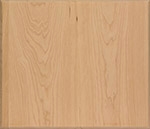 Select: No knots, no sapwood, well-matched wood.
Select: No knots, no sapwood, well-matched wood.
Hickory
Hickory is known for its mix of light and dark brown color. We offer a Budget Hickory that is a very good quality, mostly white hickory with less variation. All white wood is available upon request. We offer three grades of standard hickory.
 Rustic: Knotty, open knots, worm holes, natural color variation.
Rustic: Knotty, open knots, worm holes, natural color variation. Natural: Small mineral streaks, pin knots, natural color variation.
Natural: Small mineral streaks, pin knots, natural color variation. Select: Pleasing color matching of heartwood and sapwood.
Select: Pleasing color matching of heartwood and sapwood.
Sugar Maple
Also known as hard maple, this is a very hard wood. It is known for its light color in our Select grade. Our natural and rustic grades could have a mixture of light and darker brown color. We offer three grades of sugar maple.
 Rustic: Knotty wood with natural color variation.
Rustic: Knotty wood with natural color variation.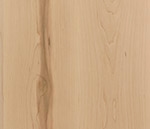 Natural: Some mineral streaks and color variation.
Natural: Some mineral streaks and color variation. Select: No knots, uniform color, well-matched wood.
Select: No knots, uniform color, well-matched wood.
Pine
Pine is a softwood that is known for its light color, which can make a kitchen look bright and airy. We offer two grades of pine.
 Rustic: Knotty wood with natural color variation.
Rustic: Knotty wood with natural color variation.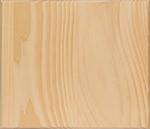 Select: No knots, uniform color, well-matched wood.
Select: No knots, uniform color, well-matched wood.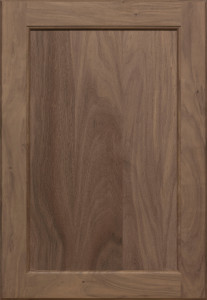
Walnut
Walnut is a hardwood known for its rich, dark brown color and wavy grain. It's a good choice for traditional or transitional style kitchens. The rich color of walnut can make a kitchen look elegant and sophisticated. We offer three grades of walnut.
 Rustic: Some knots and natural blemish.
Rustic: Some knots and natural blemish. Natural: Some color variation.
Natural: Some color variation. Select: No knots, more uniform color, well-matched wood.
Select: No knots, more uniform color, well-matched wood.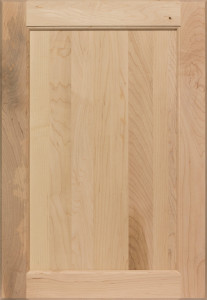
Paint Grade
This type of wood is typically Birch, Maple, or Cherry. Paint grade wood is less expensive since it is not color and grain matched. It's a good choice for painted cabinets, as it takes paint well. We offer three grades.
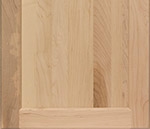 Natural: Mixed hardwood - Birch, Maple, or Cherry.
Natural: Mixed hardwood - Birch, Maple, or Cherry.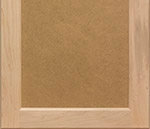 MDF Panel: MDF has superior resistance to warping, expansion, and contraction.
MDF Panel: MDF has superior resistance to warping, expansion, and contraction.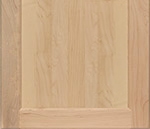 Maple: Only Maple wood used.
Maple: Only Maple wood used.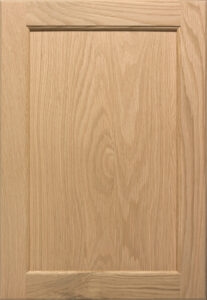
White Oak
A popular choice because it is both strong and beautiful, characterized by a slightly cooler, grey color tone. We also offer rift sawn and quarter sawn white oak for where extra stability and straight grains are desired.
 Natural: Some mineral streaks and color variation.
Natural: Some mineral streaks and color variation.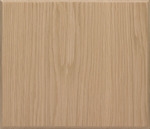 Select: No knots, uniform color, well-matched wood.
Select: No knots, uniform color, well-matched wood.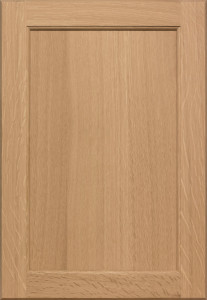
Quarter Sawn White Oak
This oak is cut so the grain runs perpendicular to the face, resulting in wide, wavy stripes. It's strong, beautiful, and has a cooler, grey color tone instead of stronger yellow and red tones.
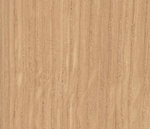 Natural: Some small pin knots, some flecking, uniform quarter sawn grain.
Natural: Some small pin knots, some flecking, uniform quarter sawn grain.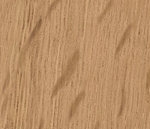 More Flecking: Hand-picked for more pronounced flecking, better color matching.
More Flecking: Hand-picked for more pronounced flecking, better color matching.
Rift Sawn White Oak
This oak is cut so the grain runs at a 30-60 degree angle to the face, resulting in long, straight grains without flecking. It's strong, beautiful, and has a slightly cooler, grey color tone.
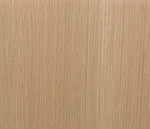 Natural: Some mineral streaks and color variation.
Natural: Some mineral streaks and color variation. Select: No knots, uniform color, well-matched wood.
Select: No knots, uniform color, well-matched wood.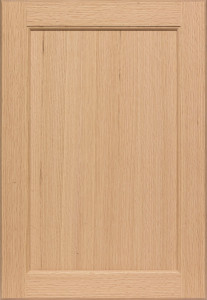
Quarter Sawn Red Oak
Similar to quarter sawn white oak, but with a darker, warmer color. It's a popular choice and can be stained to match any décor. We offer two grades.
 Natural: Some small pin knots and some flecking.
Natural: Some small pin knots and some flecking.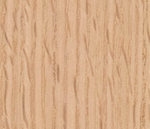 More Flecking: Hand-picked for more pronounced flecking.
More Flecking: Hand-picked for more pronounced flecking.
Ash
Ash is a hardwood known for its strength and durability. It has a light brown color and is a good choice for high-traffic areas. We offer two grades of ash.
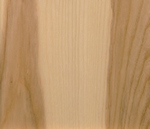 Natural: Some mineral streaks and plank boundary color variation.
Natural: Some mineral streaks and plank boundary color variation.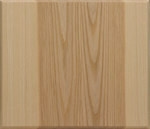 Select: Well-matched wood grain and color.
Select: Well-matched wood grain and color.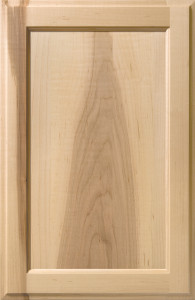
Red Leaf Maple
Similar to hard sugar maple but somewhat softer and more durable, as it’s not as brittle. It also absorbs stain better, which is helpful for dark stains. We offer three grades.
 Rustic: Knotty wood with natural color variation.
Rustic: Knotty wood with natural color variation.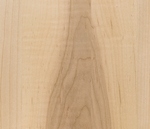 Natural: Some mineral streaks and color variation.
Natural: Some mineral streaks and color variation.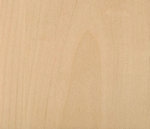 Select: No knots, uniform color, well-matched wood.
Select: No knots, uniform color, well-matched wood.
Alder
Alder is somewhat softer than other hardwoods. We offer two grades of Alder.
 Rustic: Knotty wood with natural color variation.
Rustic: Knotty wood with natural color variation. Select: No knots, uniform color, well-matched wood.
Select: No knots, uniform color, well-matched wood.Note: wood appearances may vary for each door.
Hinge Drilling Specs

Hinge drilling (optional)
- Depth: 7/16″
- Centered distance from top edge and bottom edge: 3″
- Distance from side edge: 1/8″
- Width of hole: 35mm
- two pilot holes drilled for screws per hinge
Door specs
- Thickness: 3/4″
- Frame width: 2 1/4″ or optional 3″ (call for other sizes)
- All doors are belt sanded and hand sanded
